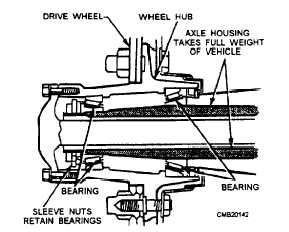the internal parts can be inspected, removed, and installed. Lubricant filler plugs are usually incorporated in the housing inspection cover.
To prevent pressure buildup when the axle becomes warm, a breather vent or valve is provided atop the housing. Without this valve, the resulting pressure could force the axle lubricant past the rear wheel oil seals and damage the brake linings. The valve is constructed so air may pass in or out of the axle housing; however, dirt and moisture are kept out.
REAR DRIVE AXLE
The rear drive axle connects the differential side gears to the drive wheels. The axle may or may not support the weight of the vehicle. Rear axles are normally induction hardened for increased strength. There are several types of rear axle designs: semifloating, three-quarter floating, and full floating. However the semi- and full-floating types are the most common. Most automobiles use the semifloating type, whereas four-wheel drive vehicles and trucks use full floating axles.
Semifloating Axle
The semifloating axle is used in passenger vehicles and light trucks. In vehicles equipped with this type of axle, the shaft, as well as the housing, supports the weight of the vehicle. The inner end of the axle is carried by the side gears in the differential housing. This relieves the axle shafts of the weight of the differential and the stresses caused by its operation that are taken by the axle housing. The inner ends of the axle transmit only turning effort, or torque, and are not acted upon by any other force.
The outer end is carried by a bearing located between the shaft and the housing. A tapered roller of ball-type bearing transfers the load from the shaft to the housing. The axle shafts take the stresses caused by turning, skidding, or wobbling of the wheels.
The axle shafts (fig. 5-23) are flanged or tapered on the ends. When the tapered axle is used, the brake drum and hub are pressed onto the shafts, using keys to prevent the assemblies from turning on the shafts. In some cases, the outer ends of the shafts may have serrations or splines to correspond with those on the drum and hub assembly. Should the axle break with this type of axle assembly, the wheel can separate from the vehicle.

Figure 5-23. - Semifloating axle installation.
Full-Floating Axle
The full-floating axle (fig. 5-24) is used in many heavy-duty trucks. The drive wheel is carried on the outer end of the axle housing by a pair of tapered roller bearings. The bearings are located outside the axle housing. In this way, the axle housings take the full weight of the vehicle and absorb all stresses or end thrust caused by turning, skidding, and pulling. Only the axle shaft transmits torque from the differential.

Figure 5-24. - Full-floating axle shaft.
Continue Reading